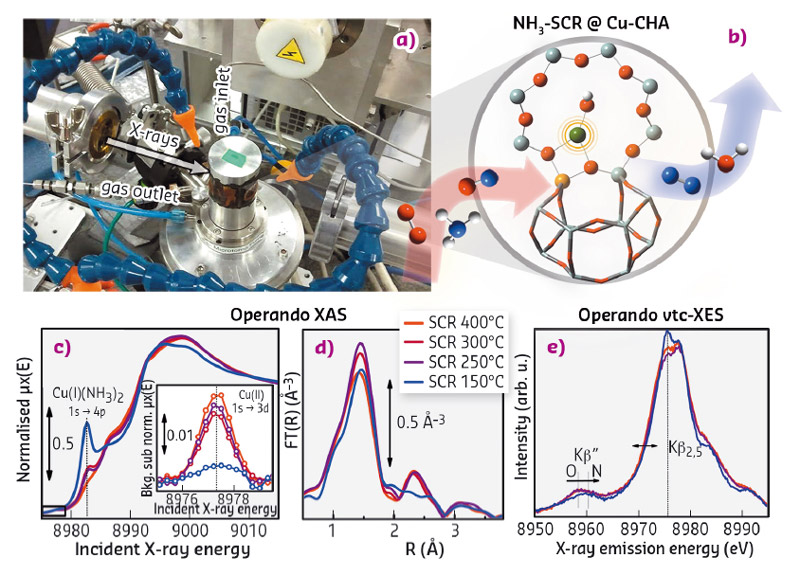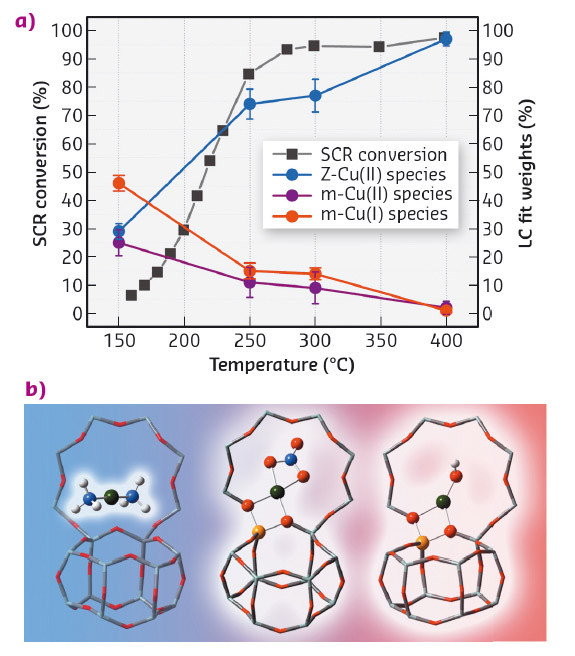- Home
- Users & Science
- Scientific Documentation
- ESRF Highlights
- ESRF Highlights 2016
- Matter at extremes
- XAS and XES unravel Cu-speciation in zeolite-based deNOx catalysts in operando conditions
XAS and XES unravel Cu-speciation in zeolite-based deNOx catalysts in operando conditions
To design improved zeolite-based deNOx catalysts, a complete understanding of both structural and electronic properties of the metal active sites at the atomic scale under lean conditions is required. We have combined operando XAS and XES to monitor the Cu-CHA catalyst during an NH3-SCR reaction in the 150-400°C range, revealing a strong influence of operation temperature on Cu-speciation.
NH3-assisted selective catalytic reduction (NH3-SCR) catalysed by metal-exchanged zeolites is a promising way to remove hazardous NOx from diesel engine exhaust gases. Cu-exchanged chabazite (Cu-CHA) has been selected as one of the best candidates for commercial SCR applications, due to its enhanced catalytic activity and hydrothermal stability [1,2]. Despite several advances in recent years, the rationalisation of the structure-performance relationship in this outstanding catalyst is still an ongoing challenge.
 |
|
Fig. 118: a) Experimental setup for operando XAS/XES on the Cu-CHA catalyst during temperature-dependent NH3-SCR at BM23. b) Schematic representation of the SCR reaction on isolated Cu-sites in Cu-CHA. (c-e) Temperature-dependent c) XANES, d) FT-EXAFS and e) vtc-XES spectra of Cu-CHA during NH3-SCR in the 150-400°C range. |
We have combined X-ray absorption (XAS) and valence-to-core emission spectroscopy (vtc-XES) at beamlines BM23 and ID26 to shed light on the Cu active sites hosted by the CHA zeolite [3-5]. We employed an ESRF microtomo reactor cell connected to a gas rig to monitor the Cu-CHA catalyst at temperatures and gas compositions relevant for industrial applications (Figure 118a). This versatile experimental setup allowed us to gradually tackle the structural complexity of the investigated system. Initially, we probed in situ the catalyst dehydration process, revealing that redox-active Z−[Cu(II)OH-] complexes (where Z denotes a charge balancing Al site, Figure 118b) represent the largely dominant coordination environment in the investigated catalyst [3]. Subsequently, in situ experiments allowed us to separately explore oxidation and reduction catalytic half-cycles, supporting a consistent scheme for the SCR reaction on isolated Cu sites in Cu-CHA [4-6].
In our most recent study, we have exploited the unique sensitivity of the XAS/XES techniques to monitor the Cu-CHA catalyst ‘in action’ during operando NH3-SCR experiments in the 150-400 °C range (Figure 118c-e).
We applied linear combination (LC) fit analysis of operando XANES employing a series of well-characterised Cu-references (Figure 119) and validated the results by complementary operando EXAFS and vtc-XES data to quantitatively estimate temperature-dependent Cu-speciation during SCR. Operando XAS/XES during SCR revealed a strong influence of reaction temperature on Cu-speciation. In agreement with the recent study by Paolucci et al. [7], in the low-temperature range up to ca. 200°C, the catalyst hosts balanced populations of Cu(I)/Cu(II) sites, with a dominant presence of mobile NH3-solvated Cu-species. A different scenario was revealed in the 250-400°C range: Cu is largely present as framework-coordinated Cu(II) species, with preferential O-ligation, accounting for ca. 70% to more than 90% of total Cu sites. Importantly, the transition between low- and high-temperature ranges for Cu-speciation matches the steep rise in the SCR conversion rate, qualitatively evaluated during operando XAS/XES experiments and measured by dedicated laboratory catalytic tests (Figure 119a, black squares).
 |
|
Fig. 119: a) Cu-speciation during temperature-dependent SCR on Cu-CHA from LC fit analysis of operando XANES spectra (circles, right axis) and NH3-SCR conversion rate (squares, left axis). Reported Cu-species include framework-coordinated Cu(II), labelled as Z-Cu(II), and mobile Cu(II) and Cu(I) complexes, labeled as m-Cu(II) and m-Cu(I), respectively. b) Structural snapshots of the dominant Cu-species for each probed temperature: mobile [Cu(I)(NH3)2]+ complexes in the low-temperature range and framework-coordinated Cu(II) moieties in the high-temperature range (colour code: Cu: green, O: red, N: blue, Al: yellow, Si: grey, H: white). |
These results highlight the strong influence of operation temperature and reactive environment on Cu-speciation in zeolite-based deNOx catalysts, demonstrating the potential of operando synchrotron-based spectroscopies in heterogeneous catalysis.
Principal publication and authors
The Cu-CHA deNOx catalyst in action: temperature-dependent NH3-assisted selective catalytic reduction monitored by operando XAS and XES, K.A. Lomachenko (a,b), E. Borfecchia (a), C. Negri (a), G. Berlier (a), C. Lamberti (a,b), P. Beato (c), H. Falsig (c) and S. Bordiga (a), J. Am. Chem. Soc. 138, 12025-12028 (2016); doi: 10.1021/jacs.6b06809.
(a) Department of Chemistry, NIS Centre and INSTM Reference Center, University of Turin (Italy)
(b) IRC “Smart Materials, Southern Federal University, Rostov-on-Don (Russia)
(c) Haldor Topsøe A/S, Lyngby (Denmark)
References
[1] U. Deka et al., ACS Catal. 3, 413-427 (2013). A.M. Beale et al., Chem. Soc. Rev. 44, 7371-7405 (2015).
[2] K.A. Lomachenko, et al., J. Phys.: Conf. Ser., 712, Art. n. 012041 (2016).
[3] E. Borfecchia et al., Chem. Sci. 6, 548 (2015).
[4] F. Giordanino et al., J. Phys. Chem. Lett. 5, 1552-1559 (2014).
[5] T.V.W. Janssens et al., ACS Catal. 5, 2832-2845 (2015).
[6] C. Tyrsted et al., Catal. Sci. Technol. 6, 8314-8324 (2016).
[7] C. Paolucci et al., J. Am. Chem. Soc. 138, 6028-6048 (2016).



